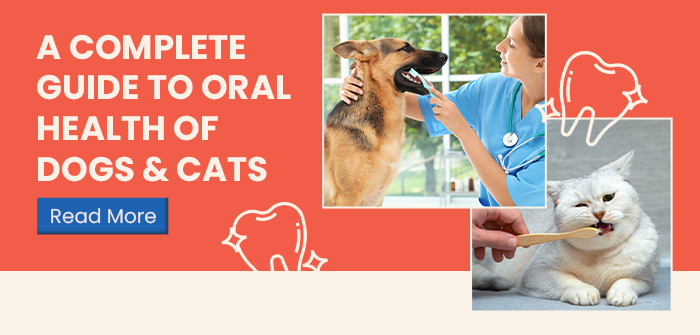A Complete Guide to Oral Health of Dogs & Cats

The Dental Health Week is the perfect reminder that oral hygiene isn’t just for humans. Our pets – both cats and dogs – are at serious risk of dental issues if left unchecked. Over 70% of adult cats and dogs develop dental disease by age three, often without visible symptoms until it’s severe. But with the right habits and tools, these problems are entirely preventable.
In this guide, we cover everything you need to know about oral health for pets, from spotting early signs to prevention tips and at-home routines for both cats and dogs.
Dental Health in Dogs: What to Know
Bad breath isn’t just a quirk trait-it’s one of the earliest signs of dental disease in dogs. You may notice:
- yellow or brown tartar buildup
- inflamed or bleeding gums
- reluctance to eat or play with chew toys
- pawing at the mouth or changes in chewing behaviour
When plaque hardens into tartar, it leads to gingivitis, tooth loss, and even infections that may spread to the heart or kidneys.
How to Prevent Dog Dental Disease?
Brushing is still the gold standard. Aim for dog teeth cleaning at least three times a week using a dog-specific toothbrush and toothpaste. But it’s not the only option.
Add-ons that help:
- Chew toys and dog tartar control treats
- Oral rinses or water additives
- Annual vet dental exams
One popular vet-recommended option is the OraVet Dental Chew for Dogs. These once-a-day chews do more than clean – they contain delmopinol, a compound that forms a protective barrier to block bacteria and prevent plaque..
If your dog prefers variety or plant-based options, the Whimzees Alligator, Brushzees & Stix Variety Value Box is a great alternative, offering mechanical cleaning through fun textures and shapes your dog will enjoy.
Cat Dental Health: Often Overlooked, But Crucial
Cats tend to suffer in silence. By the time symptoms appear, dental issues may already be advanced. Look for the signs such as,
- drooling or pawing at the face
- loss of appetite or chewing only on one side
- bad breath
- gum redness or visible plaque build-up
Routine care is essential for cat dental disease prevention, especially since many cats hide pain extremely well.
Prevention Tips for Cat Parents
Brushing is ideal, but not always practical. If that’s not an option, try these alternatives:
- Dental diets or enzymatic powders
- Dental chews for cats
- Annual professional cleanings
One great daily option is the Greenies Feline Dental Treats – Salmon Flavour. These crunchy bites are both tasty and functional, helping reduce tartar with every chew.
If your cat prefers a sprinkle-over supplement, the Vet’s Best Plaque & Tartar Dental Powder for Cats is made with natural ingredients like seaweed.
Dental Care for Kittens and Puppies
Start young. Kitten dental care can begin once the baby teeth erupt (around 3 weeks of age). These fall out by 6 months, but early exposure to kitten oral care builds tolerance.
Support their development by:
- using finger brushes and flavoured pet toothpaste
- offering teething-friendly toys
- booking check-ups during vet visits
For puppies, the KONG Teething Dental Stick Puppy Toy is a perfect choice. Its soft rubber soothes tender gums while encouraging early-stage dental hygiene for puppies through natural play.
How to Maintain Pet Oral Health at Home?
Still wondering how to maintain your pet’s oral health at home? Consistency is key. Here’s your simple starter routine:
- Brush 2-3x a week (daily if possible)
- Use chews suited to your pet’s age, species, and size
- Add oral rinses or water additives to meals or bowls
- Observe for discomfort or changes in eating
When brushing, use Dentipet Toothpaste for Dogs and Cats, which comes in chicken and beef flavours and is safe for both dogs and cats.
For fussier pets, try something gentler like Aquadent Fresh Water Additives. Just add it to their water bowl to maintain oral health for pets while they hydrate.
When to Call the Vet?
You’ve brushed; you’ve chewed – Now what? Sometimes, signs of deeper issues may still appear. Here’s how to spot dental disease in your pet that needs expert attention:
- Bleeding or swollen gums
- Visible tooth decay
- Persistent bad breath
- Refusing food or chewing oddly
Your vet may suggest X-rays or a deep clean under anaesthesia to address issues below the gumline.
On a Final Note,
Dental hygiene for pets isn’t just about fresh breath – it’s about whole-body health. Whether you’re brushing your dog’s teeth or introducing kitten teeth cleaning tools, every little step contributes to their overall health.
Start young, be consistent and normalise your pet’s dental care routine. Celebrate Pet Dental Health Month by exploring our full range of dental care essentials today and enjoy an extra 10% off on all dental products and treats! Use code: DENTAL10 at checkout. Valid from 1st–31st August 2025 – don’t miss out on this limited-time deal!